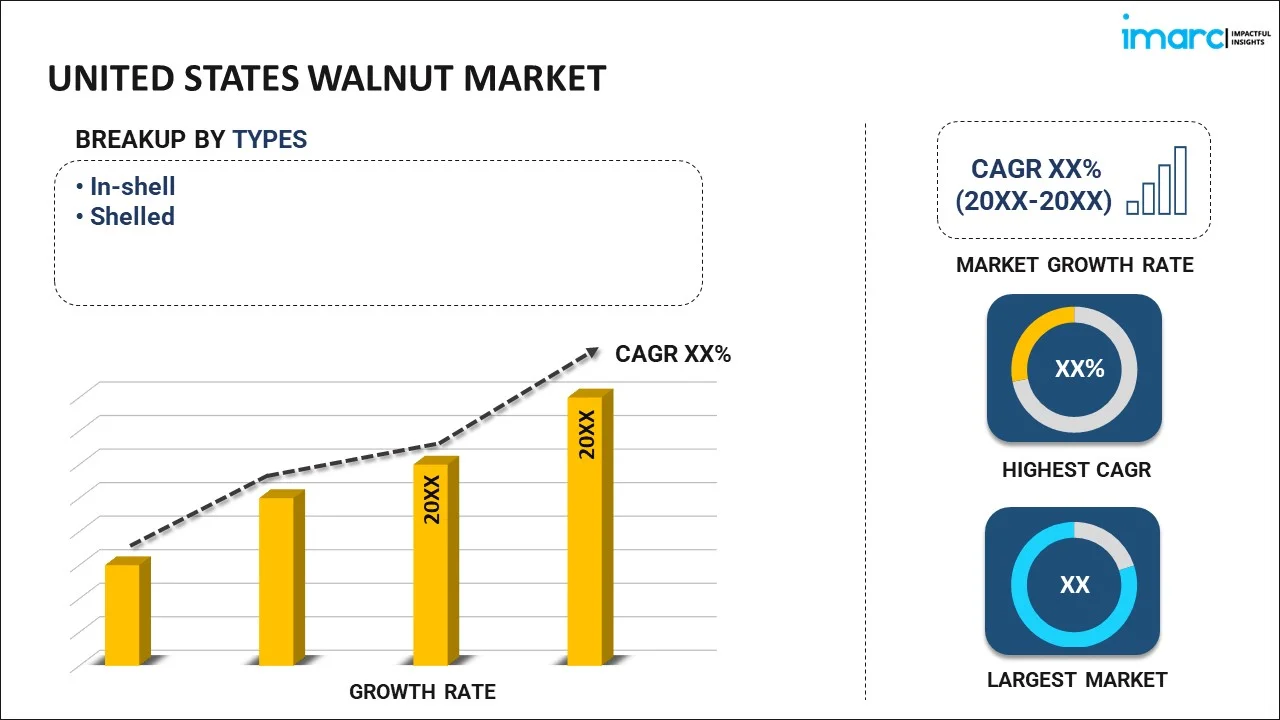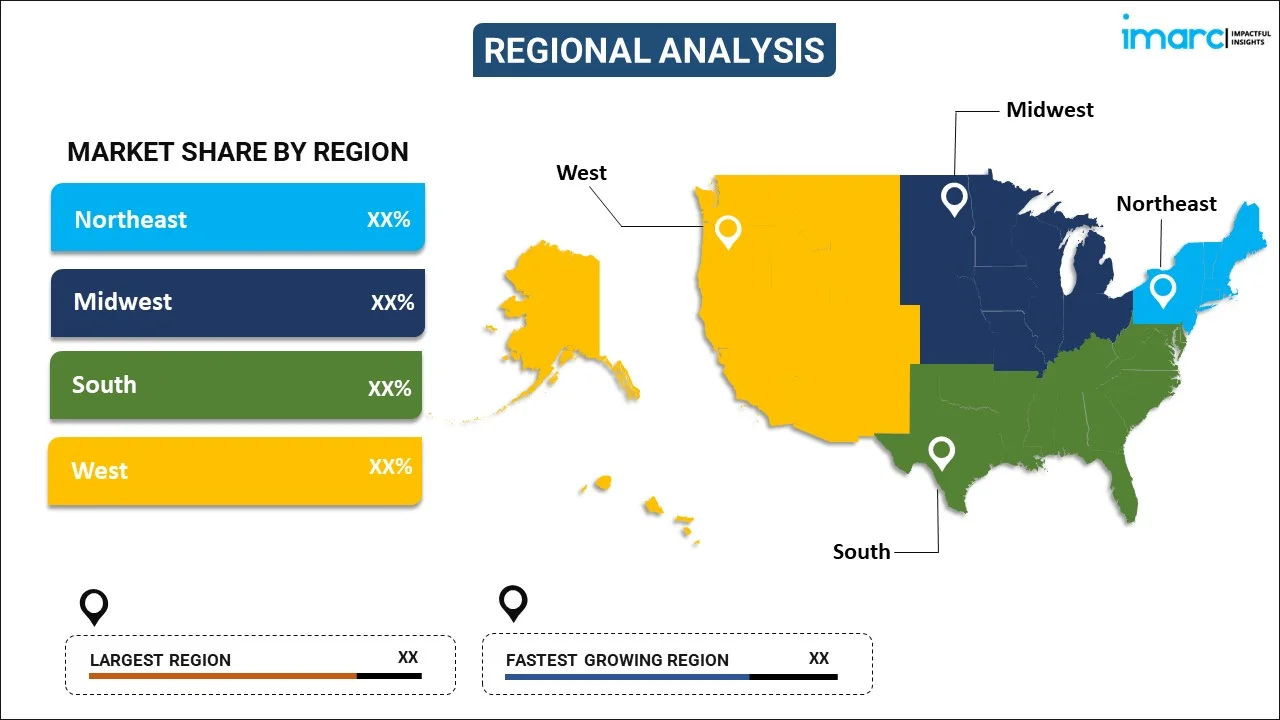
United States Walnut Market Report by Type (In-shell, Shelled), Product (Persian or English Walnut, Black Walnut), Nature (Organic, Conventional), Form (Raw, Processed), End Use (Household, Industrial, Personal Care and Cosmetics, and Others), and Region 2025-2033
Market Overview:
The United States walnut market size reached USD 2,147 Million in 2024. Looking forward, IMARC Group expects the market to reach USD 2,819 Million by 2033, exhibiting a growth rate (CAGR) of 3.1% during 2025-2033. The growing awareness of the health benefits of walnuts among the masses, the increasing focus on sustainable and locally sourced products and the rise in veganism and plant-based diets represent some of the key factors driving the market.
|
Report Attribute
|
Key Statistics
|
|---|---|
|
Base Year
|
2024 |
|
Forecast Years
|
2025-2033
|
|
Historical Years
|
2019-2024
|
| Market Size in 2024 | USD 2,147 Million |
| Market Forecast in 2033 | USD 2,819 Million |
| Market Growth Rate (2025-2033) | 3.1% |
Walnut, scientifically known as Juglans regia, is a popular and nutritious tree nut widely cultivated and consumed around the United States. The walnut tree is a deciduous species that can reach impressive heights and is prized for its timber as well. The walnut seed, commonly referred to as the walnut kernel, is enclosed within a hard, woody shell or hull. The kernel itself is rich in healthy fats, particularly omega-3 fatty acids, which are essential for brain health and cardiovascular well-being. Additionally, walnuts are an excellent source of protein, fiber, vitamins, and minerals, including vitamin E, magnesium, phosphorus, and manganese. The culinary versatility of walnuts makes them a cherished ingredient in various cuisines worldwide. They can be enjoyed raw as a nutritious snack or incorporated into both sweet and savory dishes. Crushed or ground walnuts are often used in baking, adding a delightful nutty flavor and a crunchy texture to cakes, cookies, and pastries. In savory dishes, walnuts are featured in salads, pesto, and stuffing, enhancing the taste and nutritional value of these preparations. Apart from their nutritional and health advantages, walnuts have been a part of traditional medicine in various cultures. Extracts from walnut leaves, bark, and roots have been used for their antimicrobial and astringent properties.
United States Walnut Market Trends:
The United States walnut market is driven by the growing awareness of the health benefits of walnuts. Walnuts are a rich source of healthy fats, including omega-3 fatty acids making them a popular choice among health-conscious consumers seeking nutritious and wholesome food options. Moreover, the rise in veganism and plant-based diets has led to an increased demand for plant-based protein sources. Walnuts are a valuable plant-based protein option, appealing to consumers seeking alternatives to animal-based products. As more individuals adopt these dietary preferences, the demand for walnuts as a nutritious and sustainable protein source continues to grow. Additionally, the snacking culture in the United States has contributed to the rising demand for convenient and healthy snack options. Walnuts, with their crunchy texture and nutty taste, serve as a popular on-the-go snack choice, offering a satisfying and nutritious alternative to traditional unhealthy snacks. Furthermore, the increasing focus on sustainable and locally sourced products has influenced consumer preferences in the United States. Walnuts, being a domestically grown crop in certain regions of the country, fit well with the trend of supporting local and sustainable food choices, thereby driving demand for US-grown walnuts.
United States Walnut Industry Segmentation:
IMARC Group provides an analysis of the key trends in each segment of the United States walnut market report, along with forecasts t the country level for 2025-2033. Our report has categorized the market based on type, product, nature, form, and end use.
Breakup by Type:

- In-shell
- Shelled
The report has provided a detailed breakup and analysis of the United States walnut market based on the type. This includes in-shell and shelled.
Breakup by Product:
- Persian or English Walnut
- Black Walnut
A detailed breakup and analysis of the United States walnut market based on the producta has also been provided in the report. This includes persian or english walnut and black walnut.
Breakup by Nature:
- Organic
- Conventional
The report has provided a detailed breakup and analysis of the United States walnut market based on the nature. This includes organic and conventional.
Breakup by Form:
- Raw
- Processed
A detailed breakup and analysis of the United States walnut market based on the form has also been provided in the report. This includes raw and processed.
Breakup by End Use:
- Household
- Industrial
- Personal Care and Cosmetics
- Others
A detailed breakup and analysis of the United States walnut market based on the end use has also been provided in the report. This includes household, industrial, personal care and cosmetics, and others.
Breakup by Region:

- Northeast
- Midwest
- South
- West
The report has also provided a comprehensive analysis of all the major regional markets, which include Northeast, Midwest, South and West.
Competitive Landscape:
The report has also provided a comprehensive analysis of the competitive landscape in the market. Competitive analysis such as market structure, key player positioning, top winning strategies, competitive dashboard, and company evaluation quadrant has been covered in the report. Also, detailed profiles of all major companies have been provided.
United States Walnut Market Report Scope:
| Report Features | Details |
|---|---|
| Base Year of the Analysis | 2024 |
| Historical Period | 2019-2024 |
| Forecast Period | 2025-2033 |
| Units | Million USD |
| Scope of the Report | Exploration of Historical and Forecast Trends, Industry Catalysts and Challenges, Segment-Wise Historical and Predictive Market Assessment:
|
| Types Covered | In-shell, Shelled |
| Products Covered | Persian or English Walnut, Black Walnut |
| Natures Covered | Organic, Conventional |
| Forms Covered | Raw, Processed |
| End Uses Covered | Household, Industrial, Personal Care and Cosmetics, Others |
| Regions Covered | Northeast, Midwest, South, West |
| Customization Scope | 10% Free Customization |
| Post-Sale Analyst Support | 10-12 Weeks |
| Delivery Format | PDF and Excel through Email (We can also provide the editable version of the report in PPT/Word format on special request) |
Key Questions Answered in This Report:
- How has the United States walnut market performed so far and how will it perform in the coming years?
- What has been the impact of COVID-19 on the United States walnut market?
- What is the breakup of the United States walnut market on the basis of type?
- What is the breakup of the United States walnut market on the basis of product?
- What is the breakup of the United States walnut market on the basis of nature?
- What is the breakup of the United States walnut market on the basis of form?
- What is the breakup of the United States walnut market on the basis of end use?
- What are the various stages in the value chain of the United States walnut market?
- What are the key driving factors and challenges in the United States walnut market?
- What is the structure of the United States walnut market and who are the key players?
- What is the degree of competition in the United States walnut market?
Key Benefits for Stakeholders:
- IMARC’s report offers a comprehensive quantitative analysis of various market segments, historical and current market trends, market forecasts, and dynamics of the United States walnut market from 2019-2033.
- The research study provides the latest information on the market drivers, challenges, and opportunities in the United States walnut market.
- Porter's five forces analysis assist stakeholders in assessing the impact of new entrants, competitive rivalry, supplier power, buyer power, and the threat of substitution. It helps stakeholders to analyze the level of competition within the United States walnut industry and its attractiveness.
- Competitive landscape allows stakeholders to understand their competitive environment and provides an insight into the current positions of key players in the market.
Need more help?
- Speak to our experienced analysts for insights on the current market scenarios.
- Include additional segments and countries to customize the report as per your requirement.
- Gain an unparalleled competitive advantage in your domain by understanding how to utilize the report and positively impacting your operations and revenue.
- For further assistance, please connect with our analysts.
 Request Customization
Request Customization
 Speak to an Analyst
Speak to an Analyst
 Request Brochure
Request Brochure
 Inquire Before Buying
Inquire Before Buying




.webp)




.webp)












